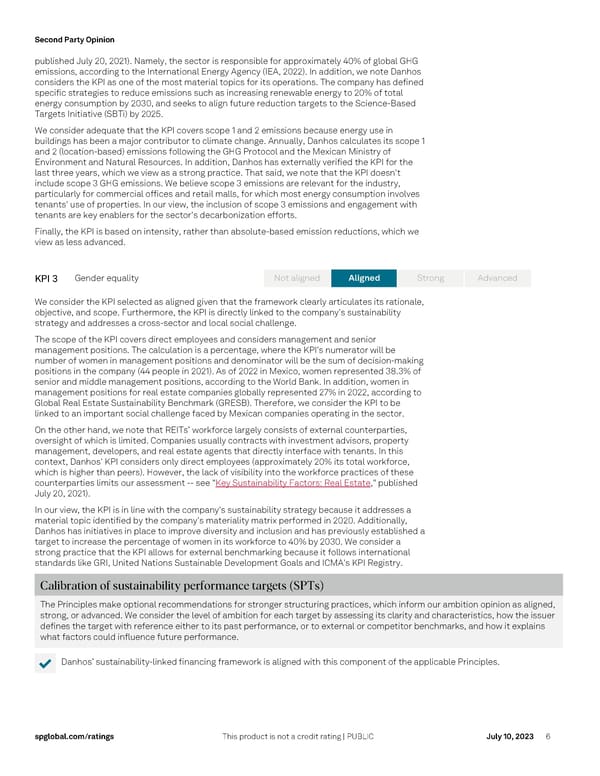Second Party Opinion s pglobal.com/ ratings This product is not a credit rating | PUBLIC July 10, 2023 6 published July 20, 2021). Namely , the sector is responsible for approximately 40% of global GHG emissions, according to the International Energy Agency (IEA, 2022). In addition, we note Danhos considers the KPI as one of the m ost m aterial topics for its operations . T he company has defined specific strategies to reduce emissions such as increasing renewable energy to 20% of total energy consumption by 2030 , and seeks to align future reduction targets to the Science- Based Targets Initiative (SBTi) by 2025. We consider adequate that the KPI co vers scope 1 and 2 emissions because energy use in buildings has been a major contributor to climate change. Annually, Danhos calculates its scope 1 and 2 (location -based) emissions following the GHG Protocol and the Mexican Minist ry of Environment and Natural Resources. In addition, Danhos has externally verified the KPI for the last three years, which we view as a strong practice. That said, w e note that the KPI doesn't include scope 3 GHG emissions. We believe scope 3 emissions are relevant for the industry, particularly for commercial offices and retail malls, for which most energy consumption involves tenant s' use of properties . In our view, t he inclusion of scope 3 emissions and engagement with tenants are key enablers for the sector's decarbonization efforts. Finally, the KPI is based on intensity , rather than absolute -based emission reductions, which we view a s less advanced . KPI 3 Gender equality We consider the KPI selected as aligned given that the framework clearly articulates its rationale, objective, and scope. Furthermore, the KPI is directly linked to the company's sustainability strategy and addresses a cross -sector and local social challenge. The scope of the KPI covers direct employees and considers management and senior management positions . The calculation is a percentage, where the KPI's numerator will be number of women in management positions and denominator will be the sum of decision- making positions in the company (44 people in 2021) . As of 2022 in Mexico, women represented 38.3% of senior and middle management positions, according to the World Bank. In addition, women in management positions for real estate companies globally represented 27% in 2022, according to Global Real Estate Sustainability Benchmark (GRESB) . Therefore, w e consider th e KPI to be linked to an important social challenge faced by Mexican companies operating in the sector. On the other hand, we note that REITs’ workforce largely consists of external counterparties, oversight of which is limited. Companies usually contracts with investment advisors, property management, developers, and real estate agents that directly interface with tenants. In this context, Danhos' KPI considers on ly direct employees ( approximately 20% its total workforce, which is higher than peers ). However, t he lack of visibility into the workforce practices of these counterparties limit s our assessment -- see “ Key Sustainability Factors: Real Estate ," published July 20, 2021). In our view, the KPI is in line with the company's sustainability strategy because it addresses a material topic identified by the company's materiality matrix performed in 2020. Additionally, Danhos ha s initiatives in place to improve diversity and inclusion and has previously established a target to increase the percentage of women in its workforce to 40% by 2030. We consider a strong practice that the KPI allow s for external benchmarking because it follows international standards like GRI, United Nations Sustainable Development Goals and ICMA's KPI Registry. Calibration of s ustainability performance targets (SPTs) The Principles make optional recommendations for stronger structuring practices, which inform our ambition opinion as aligned , strong, or advanced. We consider the level of ambition for each target by assessing its clarity and characteristics, how the issuer defines the target with reference either to its past performance, or to external or competitor benchmarks, and how it explains what factors could influence future performance. ✔ Danhos’ sustainability -linked financing framework is aligned with this component of the applicable Principles. Aligned No t aligned St rong Ad vanced
 Fibra Danhos' Sustainability Linked Financing Framework Page 5 Page 7
Fibra Danhos' Sustainability Linked Financing Framework Page 5 Page 7